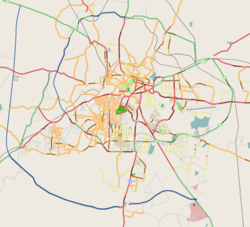Rajarajeshwari Nagar | |
|---|---|
Suburb | |
| Rajarajeshwari Nagara | |
(L-R from top) Arch at the entrance of RR Nagar, Dwadasha Jyotirlinga Temple, Shrungagiri Sri Shanmukha Swamy Temple, Sri Shivaratnapuri Temple of Health, Indo-American Hybrid Seeds, Gopalan Arcade Mall | |
| Coordinates: 12°55′48″N 77°32′10″E / 12.929949°N 77.536011°E | |
| Country | India |
| State | Karnataka |
| Metro | Bengaluru |
| Ward | 160 |
| Population (2011[1]) | |
• Total | 56,897 |
| Kannada | |
| • Official | Kannada |
| Time zone | UTC+5:30 (IST) |
| PIN | 560098 |
| Lok Sabha constituency | Bangalore Rural |
| Vidhan Sabha constituency | Rajarajeshwari Nagar |
Rajarajeshwari Nagar, officially Rajarajeshwari Nagara is a western suburb of Bangalore, Karnataka, India. It is located in the southwestern part of Bangalore along the Mysore Road, with Nagarbhavi and the Bangalore University to the north and north-west, Hosakerehalli to the east and Kengeri to the south-west. There is a prominent arch-shaped structure on Mysore Road which serves as the most popular entrance to this locality.
In historical texts this region was known as Kalyananagari, lies on the east-west meridian of Karnataka, which is situated in the southwest between the Cauvery and Vrishabhavati rivers. This place is considered the "ear" or "karnabhaga" of the several Shaktipeethas, according to the Tantra Chudamani.[2] Tiruchi Swamigal laid the foundation stone for the Jnanakshi Rajarajeshwari Temple in early 1960.[3]Known as Kenchenahalli at the time, later named as Rajarajeshwari Nagar which is named after the goddess Rajarajeshwari of the Jnanakshi Rajarajeshwari Temple.[4]The locality has plenty of greenery and has contributed to many rallies and protests regarding the nature. Ideal Homes, BEML Layout, BHEL Layout, Krishna Garden, Halagevaderahalli, Kenchenahalli, Pattanagere, Gattigere, Channasandra and Ganakal are some of the sublocalities within Rajarajeshwari Nagar.[5]
- ^ "Archived copy". Archived from the original on 30 July 2020. Retrieved 31 May 2020.
{{cite web}}: CS1 maint: archived copy as title (link) - ^ "Tantra Chudamani | PDF". Scribd. Retrieved 17 November 2024.
- ^ "Sri Rajarajeshwari Temple". web.archive.org. 8 July 2017. Retrieved 17 November 2024.
- ^ "Sri Kailash Ashrama Mahasamsthana | Rajeshwari Temple". web.archive.org. 9 May 2016. Retrieved 17 November 2024.
- ^ "Rajarajeshwari Nagar| West Bangalore | Birla Ojasvi | RR Nagar". www.birlaojasvi.ind.in. Retrieved 17 November 2024.








